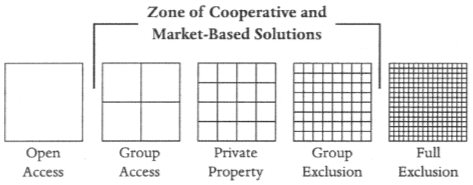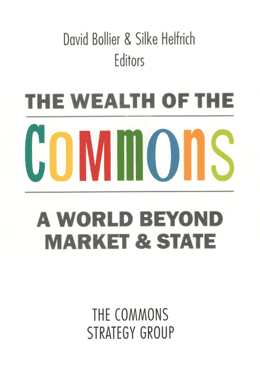This essay introduces the tragedy of the anticommons. What’s that? Let’s start with something familiar: a commons. When too many people share a single resource, we tend to overuse it – we may overfish the oceans and pollute the air. This wasteful overuse is a tragedy of the unmanaged commons. How do we solve such a tragedy?
Often, by creating private property. Private owners tend to avoid overuse because they benefit directly from conserving the resources they control. Unfortunately, privatization can overshoot. Sometimes we create too many separate owners of a single resource. Each one can block the others’ use. If cooperation fails, nobody can use the resource. Everybody loses in a hidden tragedy of the anticommons. I say “hidden” because underuse is often hard to spot. For example, who can tell when dozens of patent owners are blocking a promising line of drug research? Innovators don’t advertise the lifesaving cures they abandon.
The anticommons is a paradox. While private ownership usually increases wealth, too much ownership has the opposite effect: it wrecks markets, stops innovation, and costs lives. We can reclaim the wealth lost in a tragedy of the anticommons. But it takes tools to end ownership gridlock. The following pages provide the basic analytic tools you need: a brief overview of the anticommons lexicon (Heller 2008; 2010).
The trilogy of ownership
Traditionally, ownership has been categorized into three basic types: private, commons, and state property (Heller 2001). Let’s unpack those categories:
We all have strong intuitions about private property, but the term is surprisingly hard to pin down. A good starting point comes from William Blackstone, the foundational eighteenth-century British legal theorist. His oft-quoted definition of private property is “that sole and despotic dominion which one man claims and exercises over the external things of the world, in total exclusion of the right of any other individual in the universe.” In this view, private property is about an individual decision maker who directs resource use.
Commons property refers to shared resources, resources for which there is no single decision maker. In turn, the commons can be divided into two distinct categories (Eggertsson 2002). The first is open access, a regime in which no one at all can be excluded, like on the high seas. Mistakenly, the legal and economics literatures long conflated the commons with open access, hence reinforcing the link between commons and tragedy. The second type of commons has many names, but for now let’s call it group access, a regime in which a limited number of commoners can exclude outsiders but not each other. If the ocean is open access, then a small pond surrounded by a handful of landowners may be group access. Group access is often overlooked even though it is the predominant form of commons ownership, and is often not tragic at all; it is the core concept that this volume celebrates.
State property resembles private property in that there is a single decision maker but differs in that resource use is directed through some process that is, in principle, responsive to the needs of the public as a whole. In recent years, state property has become less central as a theoretical category: intense state regulation of resources has dropped from favor and privatization has accelerated. Today, for many observers, the property trilogy can be reduced to an opposition of private and commons property, what one scholar calls simply “all and none” (Figure 1) (Barzel 1989).

Figure 1: The Standard solution to the commons tragedy
I believe a substantial cause of our cultural blindness to the costs of fragmented ownership arises from this too simple image of property. We assume, without reflection, that the solution to overuse in an open access commons is ordinary use in private ownership. This logic makes it difficult to imagine underuse dilemmas and impossible to see the uncharted world beyond private property.
Privatizing a commons may cure the tragedy of wasteful overuse, but it may inadvertently spark the opposite. English lacks a term to denote wasteful underuse. To describe this type of fragmentation, I coined the phrase tragedy of the anticommons (Heller 1998). The term covers any setting in which too many people can block each other from creating or using a valuable resource. Rightly understood, the opposite of overuse in a commons is underuse in an anticommons.
This concept makes visible the hidden half of our ownership spectrum, a world of social relations as complex and extensive as any we have previously known (Figure 2). Beyond normal private property lies anticommons ownership. As one commentator has noted, “To simplify a little, the tragedy of the commons tells us why things are likely to fall apart, and the tragedy of the anticommons helps explain why it is often so hard to get them back together” (Fennell 2004).
Often, we think that governments need only to create clear property rights and then get out of the way. So long as rights are clear, owners can trade in markets, move resources to higher valued uses, and generate wealth. But clear rights and ordinary markets are not enough. The anticommons perspective shows that the content of property rights matters as much as the clarity. Wasteful underuse can arise when ownership rights and regulatory controls are too fragmented.

Figure 2: The revealing the hidden half of the ownership spectrum
Making the tragedy of the anticommons visible upends our intuitions about private property, which can no longer be seen as the end point of ownership. Well-functioning property instead is a fragile balance poised between the extremes of overuse and underuse.
Lessons from the commons
Solutions to commons property dilemmas give clues to solving anticommons tragedy. To start, consider the distinction between open access and group access. This distinction can do some work on the anticommons side of the spectrum as well. For open access, like the high seas, states must command resource use directly or create hybrid rights, such as fishing quotas. The anticommons parallel to open access is full exclusion in which an unlimited number of people may block each other. With full exclusion, states must expropriate fragmented rights or create hybrid property regimes so people can bundle their ownership. Otherwise, the resource will be wasted through underuse. There is, however, one important respect in which full exclusion differs from open access: an anticommons is often invisible. You have to spot the underused resource before you can respond to the dilemma.
Group access in a commons also has an anticommons parallel: group exclusion in which a limited number of owners can block each other. For both group access and group exclusion, the full array of market-based, cooperative, and regulatory solutions is available. Although self-regulation may be more complex for anticommons resources, close-knit fragment owners can sometimes organize to overcome anticommons tragedy (Depoorter and Vanneste 2007). For group exclusion resources, the regulatory focus should be support for markets to assemble ownership and removal of roadblocks to cooperation.
Group property on the commons or anticommons side of private ownership is exponentially more important than the rare extremes of open access or full exclusion. Much of the modern economy – corporations, partnerships, trusts, condominiums, even marriages – can be understood as legally structured group property forms for resolving access and exclusion dilemmas (Dagan and Heller 2001). We live or die depending on how we manage group ownership. Now, we can see the full spectrum of property, as shown in Figure 3.

Figure 3: The full spectrum of property, revealed (Heller 1999)
The spread of the anticommons idea
After I proposed the possibility of anticommons tragedy, Nobel laureate James Buchanan and his colleague Yong Yoon undertook to create a formal economic model. They wrote that the anticommons concept helps explain “how and why potential economic value may disappear into the ‘black hole’ of resource underutilization” (Buchanan and Yoon 2000).” In recent years, economic modeling of the anticommons has become quite sophisticated.
To date, the most debated application of anticommons theory has been in the area of drug patents and innovation (Heller and Eisenberg 1998). Since my 1998 Science article with Rebecca Eisenberg, there has been a flurry of follow-on papers and reports, many concluding that patents should be harder to obtain, in part to avoid potential anticommons tragedy effects. A recent book on the patent crisis concludes that, “the structure of the biotechnology industry seems likely to run high anticommons risks,” particularly when companies are attempting to bring products to market (Burk and Lemley 2009).
It’s not just biomedical research that’s susceptible to anticommons tragedy. The framework has been applied across the high tech frontier, ranging from broadcast spectrum ownership to technology patents. Also, cutting edge art and music are about mashing up and remixing many separately owned bits of culture. Even with land, the most socially important projects require assembling multiple parcels. Innovation has moved on, but we’re stuck with old-style ownership that’s easy to fragment and hard to put together.
Anticommons theory is now well established, but empirical studies have yet to catch up. How hard is it to negotiate around ownership fragmentation? How much does ownership fragmentation slow down technological innovation? Does the effect vary by industry? It is difficult to measure discoveries that should have been made but weren’t, solutions that could exist but don’t. We are just starting to examine these conundrums. A recent study reported experimental findings that reject the presumed symmetry of commons and anticommons and find instead that anticommons dilemmas “seem to elicit more individualistic behavior than commons dilemmas” and are “more prone to underuse than commons dilemmas are to overuse.” The researchers conclude that “if commons leads to ‘tragedy,’ anticommons may well lead to ‘disaster’” (Vanneste et al 2006).
Toward a new lexicon
We have millennia of practice in spotting tragedies of overuse. When too many people fish, fisheries are depleted. When too many people pollute, we choke on dirty air. Then, we spring into action with market-based, cooperative, and legislative solutions. But underuse caused by multiple owners is unfamiliar. The affected resource is hard to spot. Our language is new. Even though a tragedy of the anticommons may be as costly to society as the more familiar forms of resource misuse, we have never noticed, debated, or learned how to fix underuse. As a first step, we need to name the phenomenon: the tragedy of the anticommons should join our lexicon.
This essay is adapted from Chapter 2 of The Gridlock Economy (2010). For further resources, see http://www.gridlockeconomy.com.
References
- Barzel, Y. 1989. Economic Analysis of Property Rights. Cambridge University Press.
- Buchanan, J. and Yoon, Y. 2000. “Symmetric Tragedies: Commons and Anticommons.” Journal of Law and Economics. 43: 1.
- Burk, D. and M. Lemley. 2009. The Patent Crisis and How the Courts Can Solve It. University of Chicago Press.
- Dagan, H. and M. Heller. 2001. “The Liberal Commons.” Yale Law Journal 110: 549.
- Depoorter, B. and Vanneste, S. 2007. “Putting Humpty Dumpty Back Together: Pricing in Anticommons Property Arrangements.” Journal of Law, Economics & Policy. 3:1.
- Eggertsson, T. 2002. Open Access versus Common Property. In T. Anderson & F. McChesney, eds., Property Rights: Cooperation, Conflict, and Law. 74-85. Princeton University Press.
- Fennell, L. 2004. “Common Interest Tragedies.” Northwestern Law Review, 98:907.
- Heller, M. 1998. “The Tragedy of the Anticommons: Property in the Transition from Marx to Markets.” Harvard Law Review. 111:621.
- —————. 1999. “The Boundaries of Private Property.” Yale Law Journal. 108:1163.
- —————. 2001. “The Dynamic Analytics of Property Law.” Theoretical Inquiries in Law. 2:79.
- —————. 2008. The Gridlock Economy: How Too Much Ownership Wrecks Markets, Stops Innovation, and Costs Lives. New York: Basic Books.
- —————, editor. 2010. Commons and Anticommons. London: Elgar Publishing.
- —————, and Eisenberg, R. 1998. “Can Patents Deter Innovation? The Anticommons in Biomedical Research.” Science. 280:698.
- Vanneste, S. et al. 2006. “From ‘Tragedy’ to ‘Disaster’: Welfare Effects of Commons and Anticommons Dilemmas.” International Review of Law and Economics. 26:104.
 Buy at Levellers Press
Buy at Levellers Press 

